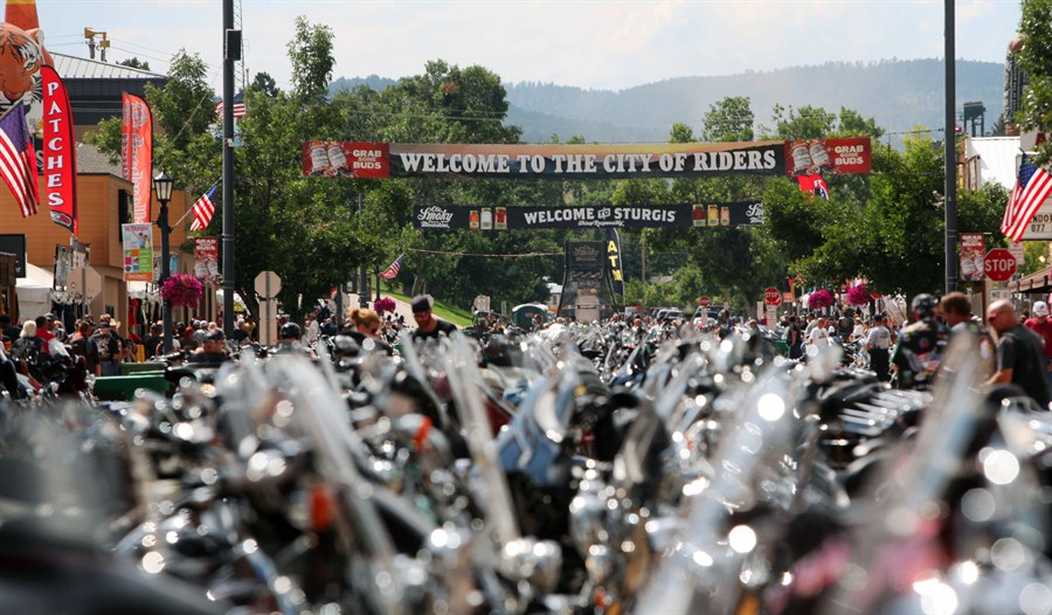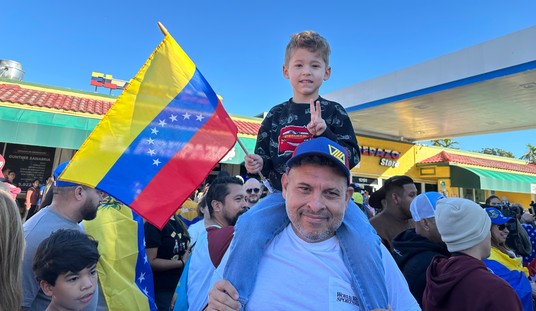The Sturgis (SD) Motorcycle Rally is underway in ends next Sunday, and the Wuhan fearmongers are hard at work demonizing the event.
If you aren’t familiar with the event, every year at this time, some 450,000 motorcyclists, plus or minus, descend upon the town of Sturgis, SD (population 6,700) for a week of consciousness-raising, scholarly conferences, and the presentation of academic papers. Of course, there are also adult beverages, substances legal and illegal, and celebrations of the biker culture…I’m looking forward to Sturgis joining “Juneteenth” on the Pantheon of holidays.
There is some mild depravity, like the Bikini Bike Wash, but nothing to compare with Anthony Fauci or Peter Duszak creating a virus to wreak havoc on the world’s economy while slaughtering its most vulnerable members.
Because the gathering runs counter to the demands of the US Department of Pandemia (h/t to @alexberenson on Twitter for that), it has been preemptively declared both dangerous and evil.
This is the Associated Press coverage:
The Black Hills of South Dakota roared with motorcycles and crowds Friday as the annual Sturgis Motorcycle Rally kicked off, with mostly mask-less rallygoers packed shoulder-to-shoulder at bars and rock shows, despite a rise in COVID-19 cases in the state.
Organizers expect at least 700,000 people during the 10-day event that is a rendezvous for bikers, who connect over their love for motorcycles. For some, it’s a once-in-a-lifetime goal to make it to Sturgis; others faithfully make the pilgrimage year after year.
“It’s just a great big family atmosphere, everybody’s out here for the same purpose — we all love motorcycles,” said Aaron Harper. “If you’re a motorcyclist, you have to see it at least once in your life.”
Public health experts — and some locals — worry the rally will again play host to coronavirus infections, after hundreds of rallygoers were infected last year. Only about 46% of adults who live in the county that hosts Sturgis are fully vaccinated, according to the U.S. Centers for Disease Control and Prevention, compared with 60.6% nationwide. Virus infections are on the rise in South Dakota after a steady decline through the spring and early summer. The Department of Health reported a 68% jump in virus infections last week, with the highly contagious delta variant spurring a larger share of those infections.
Yesterday, National Institute of Allergy and Infectious Diseases honcho Anthony Fauci was on Chuck Todd’s failing show, telling folks that they would be irresponsible to attend. You can, he said, always go next year. Or the next. Or the next. Because right now, Fauci and his cronies seem to be having as much fun jerking us about responding to the virus they helped create as they had funding the Chinese military lab that created it.
Dr. Fauci chastises those attending the Sturgis Motorcycle Rally: You’re going to get to do that in the future, but let's get this pandemic under control before we start acting like nothing is going on." pic.twitter.com/ifb6tVdMgg
— Tom Elliott (@tomselliott) August 8, 2021
If you’ve been paying attention, the Panic Porn Industry ran this same story here. I covered it in passing in Prominent China Virus Task Force Member Gets All Stompy-Foot Over the Under Classes Not Doing What They are Told.
Case in point, the huge festival in Sturgis, SD, in August.
There were no face masks and no social distancing at a time when Andrew Cuomo and Gavin Newsom and Gretchen Whitmer, and Phil Murphy were squirting like a goose in terror. How did that turn out? There was a ridiculous model pushed out by ridiculous modelers that the gathering led to 260,000 cases. Despite it being obvious bullsh** it was relentlessly fluffed by the media. But what really happened? Out of an estimated 460,000 attendees, there were a verified 414 cases and one death. The death was a Minnesota man in his 60s with several co-morbidities.
More from the Associated Press:
Last year’s rally transformed Sturgis, usually a quiet community of under 7,000 residents, into a travel hub comparable to a major U.S. city. One analysis of anonymous cellphone data found that well over half of counties in the country were visited by someone who attended Sturgis. A team of researchers from the Centers for Disease Control concluded that last year’s rally ended up looking like a “superspreader event.”
Let’s stop right there and take a look at the study at the link. The study is called Widespread Severe Acute Respiratory Syndrome Coronavirus 2 Transmission Among Attendees at a Large Motorcycle Rally and their Contacts, 30 US Jurisdictions, August–September, 2020. This is from the abstract:
The 2020 Sturgis motorcycle rally resulted in widespread transmission of severe acute respiratory syndrome coronavirus 2 across the United States. At least 649 coronavirus disease 2019 cases were identified, including secondary and tertiary spread to close contacts.
This was the methodology used by the investigators.
To summarize the number of COVID-19 cases associated with attendance at the Sturgis rally and describe the geographic spread of cases across the United States, the Centers for Disease Control and Prevention (CDC) requested information on laboratory or clinically diagnosed COVID-19 cases (Council of State and Territorial Epidemiologists. Technical guidance interim-20-ID-01: Standardized surveillance case definition and national notification for 2019 novel coronavirus disease. https://cdn.ymaws.com/www.cste.org/resource/resmgr/2020ps/interim-20-id-01_covid-19.pdf, accessed 20 February 2021) detected after travel to Sturgis/Meade County, South Dakota, August 1–30, or attendance at the Sturgis Rally, August 7–16, from 54 health departments (50 states and Washington, DC; New York City; Chicago; and Los Angeles County). Information on risk factors and travel in the previous 2 weeks was collected by health department staff via phone interviews with infected persons. Several states modified the definition of a Sturgis rally-associated case to include cases who reported any travel to South Dakota during August because of some individuals’ reluctance to disclose attendance at the Sturgis rally. [my emphasis] Data requested included total numbers of confirmed and probable cases of COVID-19 in index (primary) patients and close contacts (secondary/tertiary) (https://www.cdc.gov/coronavirus/2019-ncov/php/contact-tracing/contact-tracing-plan/contact-tracing.html, accessed 20 February 2021), and demographic characteristics and clinical outcomes for primary cases. Secondary cases were defined as laboratory or clinically diagnosed infections among persons who were close contacts of a person who attended the Sturgis rally or traveled to South Dakota between August 1 and 30. Tertiary cases were infections in close contacts of persons with secondary infections. Epidemiologic data were summarized across participating jurisdictions.
Let’s delve deeper. The study examined infections of participants, their secondary contacts, and the contacts of the secondary contacts. The obvious intent of this was to create as large a number as possible. What do those infections look like?
Of 649 reported cases, 463 (71%) laboratory-confirmed or probable primary cases were reported by 30 jurisdictions from across the country with most laboratory-confirmed cases diagnosed within two weeks of the Sturgis rally. An additional 186 (29%) secondary and tertiary cases were reported by 17 jurisdictions. Among the 463 primary cases, 17 (3.7%) persons were hospitalized and 1 died (Table 1).
Last year the official attendance was 462,000. That means that the infection rate was, at most, 0.1%. I say “at most” because the methodology description indicates that merely traveling to South Dakota would get you included as a Sturgis infection in many states. Plus, the number of infected people includes “probable” cases. Those cases resulted in a hospitalization rate of 3.7%. We can’t really evaluate the number because the study doesn’t give us a number of persons falling into the “secondary” and “tertiary” contact universe. But if you assume that each infected (real or imaginary) person had close contact with about 10 other people (family, friends, co-workers), you have over 4500 secondary contacts. Using the same model, those 4500 secondary contacts would yield about 45,000 tertiary contacts. So a possible universe of 50,000 “secondary and tertiary” contact resulted in an infection rate of about 0.37%. No matter what the number is, 463 people infecting 186 more is not a public health crisis. (Note, my theorizing on secondary and tertiary contacts is subject to what an acquaintance in the Census Bureau calls the “better number method,” which is if you’ve got a better number, I’ll use it.)
The real objection of Fauci and his fellow travelers to Sturgis is that it represents a collection of Americans who have zero f***s left to give about the Wuhan virus hysteria. They know that they can’t just come back next year because none of us are guaranteed next year. All we have is today, and every day you spend living in fear and panic over the Wuhan virus is a day of your life that you’ve thrown away. The public health nazis don’t really believe the nonsense they are yapping about. Remember last summer, the same people who condemned and are condemning Sturgis and Trump rallies and sporting events pointedly refused to admit that the BlackLivesMatter and Antifa riots convulsing so many American cities were a public health issue.
Like the Trump rallies and like the Super Bowl in 2020, “superspreader” events appear to be nothing more than just a technique used to try to stoke fear and panic in the population (Super Bowl Was Not a ‘Superspreader’ Event, Creating a Sad in the Pandemic Porn Industry).














Join the conversation as a VIP Member